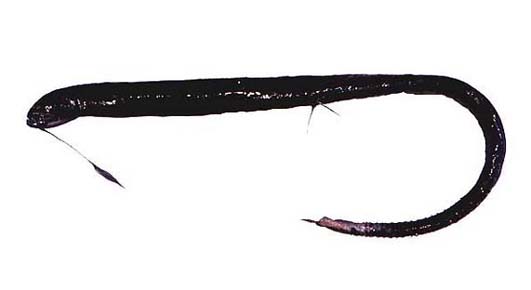ミツマタヤリウオ科
- HOME
- デジタル図鑑
- パタゴニア海域の重要水族
- 硬骨魚綱 ワニトカゲギス目 ミツマタヤリウオ科
ミツマタヤリウオ科(Idiacanthidae)

20
ナンヨウミツマタヤリウオ(Nanyoo-mitsumatayariuo)
Idiacanthus fasciola Peters, 1877
特 徴:
背鰭72軟条,臀鰭39軟条,腹鰭6軟条,鰓条骨数16。頭長は体長の7.0%,眼径は0.7%,体高は4.5%,吻長は2.4%,両眼間隔は2.0%,上顎長は6.9%,尾柄高は1.3%,腹鰭長は5.7%,肉質眼窩径は1.0%。体は細長く,わずかに側扁し,紋様も鱗もない。頭は小さく,体長は頭長の約14倍。吻は円鈍で,吻長は両眼間隔にほぼ等しく,頭長の1/3。眼は小さい。口は大きく斜位。両顎は伸出不能。両顎歯は可倒性牙状歯で,大きさは一定しない。1列の小歯が鋤骨と口蓋骨にある。顎髭は長く,頭長の約2.5倍。擬鰓はない。真の鰓耙はない。胸鰭は尾鰭より頭部に近く,ほぼ背鰭起部下に位置する(この位置は多くの標本を調べると前後する:Gibbs, 1964)。臀鰭は背鰭基底の前方から1/2直下付近に始まり,臀鰭基底長は背鰭基底長の約半分。腹鰭はない。尾鰭は極めて小さい。肛門は臀鰭起部直前に位置し,小管を備える。側線はない。体側発光器は小さくて見難い上,調査標本の皮膚がすれていて確認し難いが概数を示せば:腹鰭前発光器(IV)約30,腹部腹側発光器(VAV)約20,尾部発光器(AC)約25,胸部体側発光器(OV)約25,腹部体側発光器(VAL)約26,および腹部体側発光器(VAL)約30。眼後発光器(POSTORB)は極めて小さく,眼の水晶体より小さい。
分 布:
大西洋,東インド洋および西部赤道太平洋付近に分布する。
備 考:
ミツマタヤリウオ科魚類では雌が雄より大きくなり,形態も雌雄で異る。調査標本は雌である。
(中村 泉)
Material examined:
3 from Argentina (385.0-489.0 mm SL), FAKU AP 85; S 625, 626.
Description:
D 72; A 39; P2 6; BR 16.
HL 7.0% of SL; ED 0.7; BD 4.5; SN 2.4; IO 2.0; UJ 6.9; CD 1.3; P2L 5.7; FO 1.0 (Measurements and counts were taken only on AP 85, as S 625 and 626 were badly damaged).
Body very long and slender, slightly compressed, without marks or scales. Head small, 14 in SL. Snout round, its length slightly longer than interorbital width, about 3 in head. Eye rather small. Mouth very large and oblique, premaxillae nonprotractile. Jaw teeth mostly depressible, fang-like and variable in size. Single tooth each on vomer and palatines. Upper jaw nearly equal to head in length. Long barbel on chin, its length 2.5 times of head. No pseudobranchiae. No true gill-rakers. Pectoral fin absent. Pelvic fin with 6 rays, closer to snout than caudal fin, situated anterior to dorsal fin origin (variable; before dorsal origin and after, Gibbs, 1964). Anal fin originates below mid-dorsal fin base. Anus situated in front of anal fin origin with small duct. Lateral line absent. Luminous organs well developed on ventral side of body, postorbital luminous organ much smaller than eye.
Distribution:
This species has been known from North Atlantic Ocean and the region including the eastern Indian Ocean and western equatorial Pacific Ocean. These specimens from Argentine Patagonia obtained by RV Kaiyo Maru seem to be a new record of the occurrence of I. fasciola off the western South Atlantic.
Remarks:
End of Chin barbel shows two conditions, with or without bulblet (Gibbs, 1964). In our three specimens examined, the bulblet was not recognized as shown in figure. As our specimens were damaged and impossible to observe photophors, the arrangements of photophores are here given according to Fujii(1984): IV 33-37; VAV 13-18; AC 13-20; OV 21-28; VAL 29-37.
(Izumi NAKAMURA)

Distribution of Idiacanthus fasciola in Patagonia.

End of barbel without bulblet.